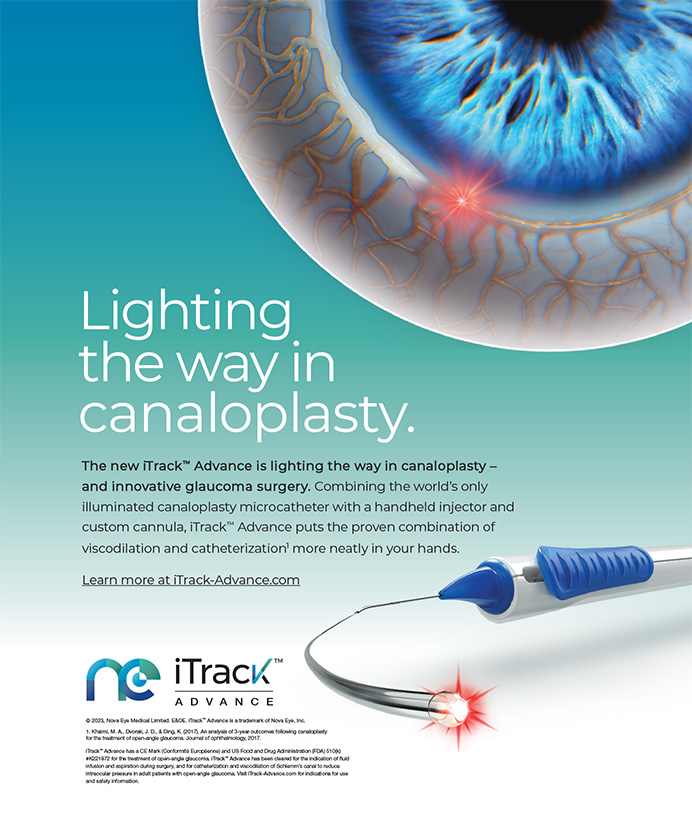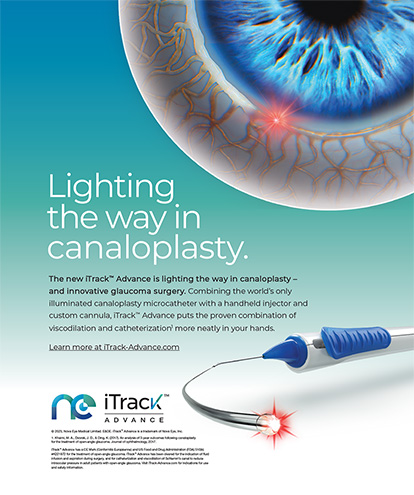
Cataract surgery benefits many glaucoma patients by improving their vision and lowering their IOP. That said, not all patients have better pressure control after surgery, and many experience significant postoperative pressure spikes. How do surgeons decide which patients may benefit from cataract surgery? Should extra precautions be taken for glaucoma patients? My coauthors and I review evidence to help answer these questions.
—Barbara Smit, MD, PhD


It has been well documented that cataract surgery effectively lowers IOP in many patients, including those with glaucoma and ocular hypertension (OHT).1,2 A large, 10-year, retrospective study reported a mean reduction in IOP of 8.5 mm Hg at the final measurement after phacoemulsification in eyes with OHT and preoperative IOPs ranging from 23 to 29 mm Hg.1 Phacoemulsification in glaucoma patients resulted in a mean decrease of 1.5 ±4.4 mm Hg and 1.9 ±4.9 mm Hg at 12 and 24 months, respectively.2 Additionally, IOP reductions up to 3 years postoperatively have been observed in patients with pseudoexfoliation glaucoma, and 2% reductions in IOP have been reported in OHT patients.3,4
The IOP-lowering effects of cataract surgery have been shown to last for 10 years and to be similar in patients of all ages.1 Cataract surgery has also been shown to reduce the need for antiglaucoma medications postoperatively, with 47% and 38% of patients no longer needing them 12 and 24 months after surgery, respectively.2 Patients with narrow-angle and angle-closure glaucoma (ACG) are particularly likely to benefit from cataract extraction,5,6 and ACG patients experience a greater reduction in pressure compared to those with open-angle glaucoma.5,6
Not all patients, however, experience a reduction in IOP after cataract surgery.1,5,7,8 What are the risks of the procedure in glaucoma patients? This article reviews the pertinent literature and outlines the factors to consider when performing cataract surgery on this population.
PREOPERATIVE IOP CONSIDERATIONS
Recent literature suggests that not all glaucoma patients experience a reduction in IOP after cataract extraction.1 The IOP-lowering effects of cataract surgery largely appear to depend on patients’ preoperative IOP. Poley et al stratified patients into five groups based on preoperative IOP.1 In the group with the lowest preoperative pressures, IOP ranged from 5 to 14 mm Hg. In the group with the highest preoperative pressures, IOP ranged from 23 to 29 mm Hg. IOP reductions were observed at the final measurement for all groups except for the one with the lowest preoperative IOPs. This group experienced a mean increase in IOP of 1.7 mm Hg at the final measurement.1 The decrease was greatest in eyes with the highest preoperative IOP (mean IOP reduction, 8.5 mm Hg). Results from the other groups suggested that the pressure reduction was proportional to the preoperative IOP. Cataract surgery therefore may not lower IOP in patients with lower preoperative IOPs. Instead, patients with low-tension glaucoma may have higher IOP and poorer pressure control after cataract surgery.
IMMEDIATE POSTOPERATIVE SPIKES
IOP may be elevated in the initial hours after cataract surgery, even after uneventful surgery. It increases gradually after the cataract procedure, peaking 5 to 7 hours postoperatively, and then decreases.9 Although IOP spikes appear to occur relatively soon after surgery, short-term increases in IOP must not be ignored.
The peer-reviewed studies describing immediate postoperative IOP effects vary widely in follow-up interval, preexisting eye disease, surgeon experience, surgical technique, and criteria for IOP elevation (range, 23-30 mm Hg10,11). Still, useful conclusions can be drawn from this research. Ahmed et al found that glaucoma patients were more likely to have an elevated IOP 3 and 7 hours postoperatively compared to patients without the disease (46.4% vs 18.4%). There were no cases of elevated IOP 1 to 4 days postoperatively.12 Similarly, the frequency of IOP elevation was 2.3% on the first postoperative day for patients without glaucoma versus up to 8.9% for patients who had preexisting eye disease, including glaucoma, or who had complicated cataract surgeries.13,14 Among patients managed by resident physicians, 22% exhibited elevated IOP on the first postoperative day, including patients with glaucoma and those who had complicated cataract surgeries.10
Rainer et al demonstrated that some viscosurgical materials may be associated with a higher frequency of elevated IOP in the first 24 hours.15,16 Viscoat (Alcon) was associated with a higher incidence of postoperative IOP spikes than DuoVisc (Alcon) and Healon5 (Abbott Medical Optics).15,16
In general, early postoperative IOP spikes may be a result of many factors, including retained viscosurgical devices, prostaglandin release, surgical technique, size of the capsulorhexis, and inflammation or obstruction of the trabecular meshwork.7,10,11 An increased likelihood of a postoperative IOP spike has been associated with eyes that have greater axial lengths, prior laser trabeculoplasty, or a higher number of preoperative glaucoma medications.7
IOP SPIKES DURING THE POSTOPERATIVE PERIOD
Topical corticosteroids are commonly prescribed after cataract surgery to reduce inflammation and complications. In steroid responders, the use of these agents can raise the IOP. About one-third of the general population is considered steroid responders and may experience an increase in IOP with the administration of topical corticosteroids.17 The proportion of patients with primary open-angle glaucoma who are steroid responders, however, is 90%.17 Additionally, greater axial length, connective tissue disease, type 1 diabetes, and a family history of glaucoma all increase an individual’s likelihood of being a steroid responder.18,19 The magnitude of steroid-induced IOP increases can range from 6 mm Hg to more than 15 mm Hg above the patient’s pretreatment baseline.19 Steroid-induced IOP elevations are often reversible, returning the pressure to baseline within weeks of discontinuing topical cortocisteroids.19 Early discontinuation of postoperative corticosteroids may be indicated in patients who cannot tolerate the period of steroid-induced IOP elevation.
RECOMMENDATIONS FOR HIGH-RISK PATIENTS
Patients who are at elevated risk of postoperative IOP spikes or who have advanced optic nerve damage should be monitored and treated accordingly. Appropriate precautions should be observed when choosing to perform surgery on these patients.
Antiglaucoma medications administered postoperatively have been shown to reduce IOP spikes in many patients.20,21 One drop of timolol maleate given immediately after cataract surgery eliminated IOP elevations greater than 30 mm Hg in all glaucoma patients in the first 24 hours.20 In comparison, 28% of glaucoma patients not treated with timolol maleate experienced IOP elevations greater than 30 mm Hg postoperatively.20 Although prophylactic antiglaucoma medications effectively lowered postoperative IOP spikes, some patients still experienced IOP elevations above 25 mm Hg. Combined cataract and glaucoma surgery is recommended when the patient should not sustain an IOP greater than 25 mm Hg for a period of at least 24 hours.20
In addition to timolol, carbonic anhydrase inhibitors appear to be effective treatments after cataract surgery.21 In a comparison of topical dorzolamide 2%, oral acetazolamide, and a control group, postoperative IOP spikes were observed 4 hours postoperatively relative to the preoperative IOP in all three groups (acetazolamide group, 6.13 mm Hg; dorzolamide group, 2.49 mm Hg; control group, 11.81 mm Hg).21 At 24 hours, the mean IOP increase was 1.2 mm Hg for the acetazolamide group, 3.18 mm Hg for the dorzolamide group, and 5.87 mm Hg for the control group. Additionally, some patients in both the acetazolamide and control groups required further IOP-lowering interventions in the first 24 hours. These data suggest that topical dorzolamide was more effective than oral acetazolamide at reducing IOP spikes in the early postoperative hours.21
CONCLUSION
With the careful removal of viscosurgical devices and appropriate use of postoperative antiglaucoma medications, cataract surgery may still be performed on high-risk patients when the visual benefits outweigh the risk of postoperative IOP elevations. Cataract surgery is unlikely to be beneficial for IOP control, however, in patients with low-tension glaucoma. Patients with advanced optic nerve damage should be treated prophylactically to prevent IOP spikes, and their IOP should be monitored in the first hours after surgery if at all possible.
1. Poley BJ, Lindstrom RL, Samuelson TW. Long-term effects of phacoemulsification with intraocular lens implantation in normotensive and ocular hypertensive eyes. J Cataract Refract Surg. 2008;34(5):735-742.
2. Mathalone N, Hyams M, Neiman S, et al. Long-term intraocular pressure control after clear corneal phacoemulsification in glaucoma patients. J Cataract Refract Surg. 2005;31(3):479-483.
3. Shingleton BJ, Gamell LS, Donoghue MWO, et al. Long-term changes in intraocular pressure after clear corneal phacoemulsification: normal patients versus glaucoma suspect and glaucoma patients. J Cataract Refract Surg. 1999;25(7):885-890.
4. Mansberger SL, Gordon MO, Jampel H, et al; Ocular Hypertension Treatment Study Group. Reduction in intraocular pressure after cataract extraction: the Ocular Hypertension Treatment Study. Ophthalmology. 2012;119(9):1826-1831.
5. Kung JS, Choi DY, Cheema AS, Singh K. Cataract surgery in the glaucoma patient. Middle East Afr J Ophthalmol. 2015;22(1):10-17.
6. Hayashi K, Hayashi H, Nakao F, Hayashi F. Effect of cataract surgery on intraocular pressure control in glaucoma patients. J Cataract Refract Surg. 2001;27(11):1779-1786.
7. Slabaugh MA, Bojikian KD, Moore DB, Chen PP. Risk factors for acute postoperative intraocular pressure elevation after phacoemulsification in glaucoma patients. J Cataract Refract Surg. 2014;40(4):538-544.
8. Brown RH, Zhong L, Whitman AL, et al. Reduced intraocular pressure after cataract surgery in patients with narrow angles and chronic angle-closure glaucoma. J Cataract Refract Surg. 2014;40(10):1610-1614.
9. Bömer T, Lagreze W, Funk J. Intraocular pressure rise after phacoemulsification with posterior chamber lens implantation: effect of prophylactic medication, wound closure, and surgeon’s. Br J Ophthalmol. 1995;(2):809-813.
10. Kim JY, Jo M-W, Brauner SC, et al. Increased intraocular pressure on the first postoperative day following resident-performed cataract surgery. Eye (Lond). 2011;25(7):929-936.
11. OBrien PDO, Ho SL, Fitzpatrick P, et al. Risk factors for a postoperative intraocular pressure spike after phacoemulsification. Can J Ophthalmol. 2007;42(1):51-55.
12. Ahmed I, Kranemann C. Revisiting early postoperative follow-up after phacoemulsification. J Cataract Refract Surg. 2002;28(1):100-108.
13. Allan B, Baer R. Conventional routine clinical review may not be necessary after uncomplicated phacoemulsification. Br J Ophthalmol. 1997; 81(7):548-550.
14. McKellar J, Elder M. The early complications of cataract surgery: is routine review of patients 1 week after cataract extraction necessary? Ophthalmology. 2001:108(5):930-935.
15. Rainer G, Stifter E, Luksch A, Menapace R. Comparison of the effect of Viscoat and DuoVisc on postoperative intraocular pressure after small-incision cataract surgery. J Cataract Refract Surg. 2008;34(2):253-257.
16. Rainer G, Menapace R. Intraocular pressure after small incision cataract surgery with Healon 5 and Viscoat. J Cataract Refract Surg. 2000;26(2):271-276.
17. Becker B. Intraocular pressure response to topical corticosteroids. Invest Ophthalmol Vis Sci. 1965;4:198-205.
18. Jones R, Rhee DJ. Corticosteroid-induced ocular hypertension and glaucoma: a brief review and update of the literature. Am J Ophthalmol. 2006:163-167.
19. Razeghinejad MR, Katz LJ. Steroid-induced iatrogenic glaucoma. Ophthalmic Res. 2012;47(2):66-80.
20. Levkovitch-Verbin H, Habot-Wilner Z, Burla N, et al. Intraocular pressure elevation within the first 24 hours after cataract surgery in patients with glaucoma or exfoliation syndrome. Ophthalmology. 2008;115(1):104-108.
21. Zohdy G, Rogers Z, Lukaris A. A comparison of the effectiveness of dorzolamide and acetazolamide in preventing post-operative intraocular pressure rise. J R Coll Surg Edinb. 1998;43:344-346.
Barbara Smit, MD, PhD
• glaucoma consultant at the Spokane Eye Clinic and a clinical instructor at the University of Washington School of Medicine in Spokane, Washington.
• (509) 456-0107; bsmit@spokaneeye.com
• financial interest: none acknowledged
Bradley P. Roth, MS
• medical student, University of Washington School of Medicine
• bradroth@uw.edu
• financial interest: none acknowledged
Aaron M. Marble, BS
• ophthalmic technician, Spokane Eye Clinic is Washington
• amarble@zagmail.gonzaga.edu
• financial interest: none acknowledged


